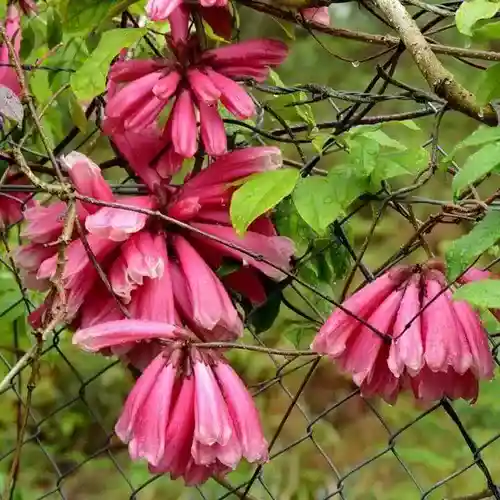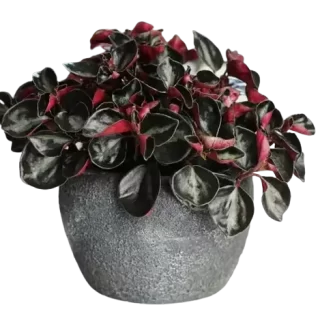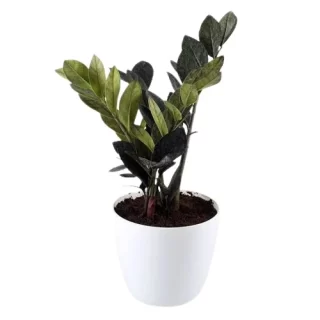Plant Size: Single Plant | Pot Included | Free Shipping
Common Names: Fraser Island Creeper, Roaring Meg (although strictly this refers to a different Tecomanthe species)
Scientific Name: Tecomanthe hillii
Synonyms: None
Family: BIGNONIACEAE
Characteristics
Fraser Island Creeper has attractive lush green, glossy, pinnate foliage on multiple twinning stems. It produces prolific skirt-like clusters of 6-cm-long, pinkish-cream throated, lipstick-pink coloured flowers on old growth during October. Tecomanthe hillii is a rare plant that is endemic to (can only be found wild in) Eastern Queensland, Australia.
Horticultural Uses
Tecomanthe hillii makes an ideal courtyard plant. It performs well when grown along fences and verandas or over pergolas or archways. Alternatively Tecomanthe hillii can also be trained up any fast-growing, open-canopied tree.
Fraser Island Creeper is also suitable for planting in pots on trellising. When grown this way it can be moved inside when it begins to flower and be used as a spectacular indoor feature plant. Tecomanthe hillii is also suitable for second-line coastal plantings in native re-vegetation projects.
There are no recorded traditional uses of Fraser Island Creeper.
Limitations When Planting
Tecomanthe hillii requires a solid support structure when planting, as its strong lianes (woody climbing stems) may damage lightweight support including the eaves of buildings. Ideally, an already established tree should be used as support for Tecomanthe hillii to grow up.
Natural Growing Environment
As its name suggests, Fraser Island Creeper is native to Fraser Island in South-East Queensland; however, there are also small isolated populations on mainland South-East and North-East Queensland. Tecomanthe hillii is often found naturally growing in sandy soils that are close to water sources throughout its range.
Fraser Island experiences an approximate average minimum temperature of 22oC and maximum of 28oC during January, and an average minimum temperature of 14oC and maximum of 20oC during July. The mean annual rainfall on Fraser Island is 1384mm, concentrated from January through to March, with 145 days of rainfall across the year.
Tips For Growing Fraser Island Creeper
Tecomanthe hillii thrives when grown in both full sunlight and in the shade and tolerates mild frosts. A Fraser Island Creeper plans exposed to full sun will have a more compact growth habit than those grown in the shade. As it doesn’t tolerate damp roots for too long, make sure you choose a location with good drainage when planting your vine.
Care should be taken to plant away from walls to avoid lime toxicity from concrete building foundations. This has the additional benefit of allowing access to as much natural rainfall as possible which may otherwise be blocked by overhanging guttering. If planting Fraser Island Creeper in containers, be sure to only use a good quality, low-phosphorus growing media. No particular pests or disease commonly affect this species.
Fertilizer and Watering
Tecomanthe hillii benefits from an application of complete native gardens slow-release fertilizer to the soil during planting. Once established, the vines can be fertilized lightly in early spring each year with a very-low-phosphate slow-release fertilizer. Although Tecomanthe hillii has low water needs once established, to achieve best results and a spectacular floral display, it’s best to water regularly. But be sure to avoid over-watering or the roots of your vine will rot.
Pruning
As far as pruning goes, Fraser Island Creeper only requires an occasional trim to keep it growing in your desired shape.
Transplanting
Tecomanthe hillii transplants readily if the plant has not already become too intertwined with its support structure. The best time to transplant Fraser Island Creeper is during late autumn or winter.
This content is accurate and true to the best of the author’s knowledge and is not meant to substitute for formal and individualized advice from a qualified professional.
Only logged in customers who have purchased this product may leave a review.











 If you need any assistance, I'm always here. Have you found what you were looking for?
If you need any assistance, I'm always here. Have you found what you were looking for?
Reviews
There are no reviews yet.